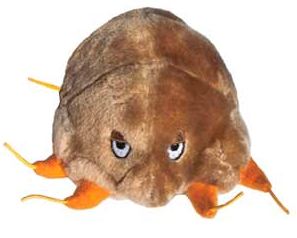
I have been hearing from a number of folks back home that there is an outbreak of itching in the
Chicagoland area. Of course, I am always in the mood for a good arthropod story, so I looked into it. (Ends up the bites are caused by arachnids, though, and not insects!)
"We don't have positive identification on the type of mite that it is. We do know that it is a mite," said Kitty Loewy, spokeswoman for the Cook County Department of Public Health. (Tribune)
Monday night, authorities left glue traps in forest preserves and other wooded areas. On Tuesday, they still didn't catch any; they think because the mites are "too small." But anyone bit by these insects are showing the telltale rash that develops 10 - 12 hours after being bitten. (The rash is a reaction to toxins in the mite's saliva as they gnaw on you as they look for larvae that aren't there. The toxin is potent (for insects at least). One mite’s bite can kill an insect larva 170,000 times its own weight.)
In the suburbs, Dr. George
Tsoutsias said "Patients were actually comparing their lesions out in the waiting room," said. He saw 32 cases this weekend in the Adventist La Grange Memorial Emergency Department.
Investigators think this outbreak may be caused by an itch mite from Europe—the
oak leaf gall mite,
Pyemotes herfsi, a relative of the straw itch mite (which farmers have dealt with for years). It feeds on midge larvae in oak trees, falling when it runs out of food, often right onto people passing below. Scientists say these European arthropods may have hitched a ride here due to increased worldwide shipping and transportation that moves new species around the world. Kansas
knows all about this, since they dealt with an
outbreak in 2004. (The
Pittsburg State University has a
site with plenty of pictures and
Quicktime videos of both the bites and the bugs.)
Information provided by entomologists indicated that these mites were associated with a gall-forming insect (a small fly called a "midge") that causes swellings along veins of oak leaves. The female midges lay eggs on the leaf surface, and the young midges crawl to the edge of the leaf or along a vein where they secrete chemicals that cause the leaf tissue to curl up into a cylinder-like gall protecting the midge larvae inside.
The itch mites prey on these midges, invading the galls, where they feed on the midge larvae and begin to reproduce. Each female mite can produce up to 250 adult offspring, most of which are females. Each generation requires only seven days, which helps explain the large population numbers that have been encountered where the problem has been serious. (like Chicago right now)
Kansas State University describes the mites' bizarre life cycle as they researched the 2004 Kansas outbreak:
The mite’s life cycle is unusual. A mated female searches for a host on which to feed. She is small enough to be carried by the wind. If she finds a rolled leaf (gall) on an oak tree, she enters the gall. If she finds midge larva, she inserts her mouthparts into the larva. Within minutes, a potent neurotoxin in her saliva paralyzes the midge larva, who will die of starvation.
Once the female starts to feed, she can develop as many as 250 offspring. In seven days, her “abdomen” is fully distended, and her young -- of which only 5 to 10% are males -- are ready to emerge as fully developed adults. Males emerge ahead of the females, and mate with the females as they emerge from the mother and die shortly after. The females complete the cycle by dispersing in search of new hosts.
Luckily, the bites are not medically dangerous, just annoying (see
video), unless people scratch enough to damage their skin, allowing bacteria to get in and cause a secondary infection. Unfortunately, bites can continue to itch for 10 - 14 days. To prevent the bites, scientists suggest wearing long clothing and insect
repellent with
DEET while outside, and
washing clothes immediately after coming indoors. To treat them, doctors recommend using hydrocortisone cream and antihistamine.
At first, some people were hypothesizing that the outbreak had something to do with the
cicada emergence earlier this summer (maybe the cicada larvae are a food source since they hatch 6-10 weeks after being deposited in the branches, and fall to the ground? Gross.). But, according to
NBC, seven other states are dealing with similar outbreaks. They are Texas, Nebraska, Kansas, Missouri, Ohio and Kentucky, so this is probably not the case. (The cicadas were mostly in northern Illinois and southern Wisconsin.)
UPDATE (
Chicago Tribune 12/15): I guess sometimes these mites COULD munch on cicada larvae. Field Museum entomologist Daniel Summers says the mite also finds immature members of the Homoptera family to be delectable, he said.
That family includes the periodic cicadas, the noisy bugs that flooded the Chicago area to mate earlier in the summer. The next generation of nymphs are emerging now, presenting an irresistible food source to any Pyemotes mite looking for something to eat.
"They're hatching out right now in the forest preserves by the countless zillions," Summers said. "It would be an endless feast for them. That would be my best guess right now."


